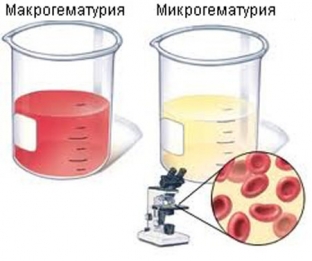Blood – it is the most important fluid of the human body, with the help of which every cell of the body is able to be saturated with oxygen. Almost every damage to body tissues is accompanied by bleeding, while the degree of blood loss determines not only the further treatment regimen, but also the prognosis for the patient's life. The appearance of blood in the urine is observed in some diseases of the urinary system, and is an alarming bell, forcing the patient to seek medical help. What is hematuria and what pathologies is indicated by the appearance of blood in the urine – read on estet-portal.com.
What diseases of the urinary system can cause blood in the urine
Very many diseases of the urinary system are accompanied by the appearance of blood in the urine, while in some cases hematuria is a mandatory symptom confirming the presence of a specific pathology, while in others – random occurrence. Patients may complain of cloudy urine, the appearance of a few drops or blood clots after urination, or urine staining in different shades of red. All this information is very important for the correct diagnosis of the pathological process in the organs of the urinary system. In cases where it is not possible to determine the pathology during the diagnosis, hematuria is called essential, and most often it is caused by impaired venous blood flow.
Blood in urine:
- macrohematuria and microhematuria: what is their main difference
- the type of hematuria depends on the cause of blood in the urine
- diagnostic algorithm for blood in urine
Macrohematuria and microhematuria: what is their main difference
Depending on the amount of blood in the urine, hematuria is divided into gross hematuria and microhematuria. Gross hematuria is diagnosed when blood impurities in the urine are visible to the eye. At the same time, the color of urine can be completely different: pink, blood-red with clots, the color of meat slops, sometimes bleeding can even be profuse. A large amount of blood in the urine is typical for oncological processes of the kidneys, bladder, urolithiasis, acute cystitis and some other urological pathologies.
 Microhematuria – this is the determination of red blood cells in the urine using a microscope. Often, microhematuria indicates the early stages of diseases of the urinary system. Quite often, microhematuria is an early symptom of a tumor process in the organs of the urinary tract.
Microhematuria – this is the determination of red blood cells in the urine using a microscope. Often, microhematuria indicates the early stages of diseases of the urinary system. Quite often, microhematuria is an early symptom of a tumor process in the organs of the urinary tract.
The type of hematuria depends on the cause of blood in the urine
For a successful diagnostic process, it is important to divide hematuria into three types, according to when blood appears in the urine:
- initial hematuria occurs at the beginning of urination and indicates a pathological process in the urethra. In this case, it is important to distinguish gross hematuria from urethrorrhagia, in which blood is determined not only during urination, but also independently of & nbsp; him. Initial hematuria does not occur in women because they do not have an enclosed space in the urethra;
- terminal hematuria occurs at the end of the act of urination, often the appearance of blood in the urine in this phase indicates an inflammatory process in the organs of the urinary system or a tumor of the bladder neck;
- total hematuria – This is a condition where blood is present in the urine throughout the entire act of urination. It can be caused by various lesions of the kidneys and bladder. If the blood is excreted in worm-like clots. Resembling the lumen of the esophagus in its shape, we are most likely talking about renal hematuria.
Diagnostic algorithm for blood in urine
Certain urological studies are needed to clarify the cause of blood in the urine. First of all, it is necessary to correctly collect the patient's history, specifying the conditions for the appearance of blood in the urine, the duration and intensity of bleeding, the presence and shape of clots, and so on. The following patterns exist:
- with urolithiasis, renal colic occurs first, and then – hematuria;
- in oncological and tuberculosis processes, blood clots are first released, and then pain appears;
- the appearance of blood in the urine after intense movements, jumping, riding indicates urolithiasis, with other pathologies, hematuria occurs for no apparent reason;
- worm-like clots indicate a renal nature of hematuria, and dysuria – about damage to the bladder.
A three-glass urine test, in which the patient is asked to pass urine alternately into three glasses, helps to determine the type of hematuria, and, accordingly, to suggest the localization of the pathological process. Cystoscopy is the most informative diagnostic method that is performed at the height of hematuria and helps to directly determine the source of bleeding.







Add a comment